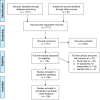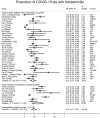Gastrointestinal and hepatic manifestations of COVID-19: A systematic review and meta-analysis
- PMID: 33363257
- PMCID: PMC7753450
- DOI: 10.1002/jgh3.12456
Gastrointestinal and hepatic manifestations of COVID-19: A systematic review and meta-analysis
Abstract
Background and aim: This review investigates the role of gastrointestinal and hepatic manifestations in COVID-19, particularly with regard to the prevalence of isolated gastrointestinal (GI) symptoms.
Methods: We searched PubMed, Embase, and Cochrane library for COVID-19 publications from 1 December 2019 to 18 May 2020. We included any study that reported the presence of GI symptoms in a sample of >5 COVID-19 patients. Data collection and risk of bias assessment were performed independently by two reviewers. Where ≥3 studies reported data sufficiently similar to allow calculation of a pooled prevalence, we performed random effects meta-analysis.
Results: This review included 17 776 COVID-19 patients from 108 studies. Isolated GI symptoms only occurred in 1% (95% confidence interval [CI] 0-6%) of patients. GI symptoms were reported in 20% (95% CI 15-24%) of patients. The most common were anorexia (21%, 95% CI 15-27%), diarrhea (13%, 95% CI 11-16%), nausea or vomiting (8%, 95% CI 6-11%), and abdominal pain (4%, 95% CI 2-6%). Transaminase elevations were present in 24% (95% CI 17-31%) of patients. Higher prevalence of GI symptoms were reported in studies published after 1st April, with prevalence of diarrhea 16% (95% CI 13-20), nausea or vomiting 12% (95% CI 8-16%), and any GI symptoms 24% (95% CI 18-34%). GI symptoms were associated with severe COVID-19 disease (odds ratio [OR] 2.1, 95% CI 1.3-3.2), but not mortality (OR 0.90, 95% CI 0.52-1.54).
Conclusions: Patients with isolated GI symptoms may represent a small but significant portion of COVID-19 cases. When testing resources are abundant, clinicians should still consider testing patients with isolated GI symptoms or unexplained transaminase elevations for COVID-19. More recent studies estimate higher overall GI involvement in COVID-19 than was previously recognized.
Keywords: COVID‐19; SARS‐CoV‐2; gastrointestinal; meta‐analysis; systematic review.
© 2020 The Authors. JGH Open published by Journal of Gastroenterology and Hepatology Foundation and John Wiley & Sons Australia, Ltd.
Figures




References
-
- CDC . Coronavirus Disease (COVID‐19) Centers for Disease Control and Prevention: US Department of Health and Human Services, 2020. Available from URL: https://www.cdc.gov/coronavirus/2019-ncov/cases-updates/cases-in-us.html...
LinkOut - more resources
Full Text Sources
Miscellaneous

